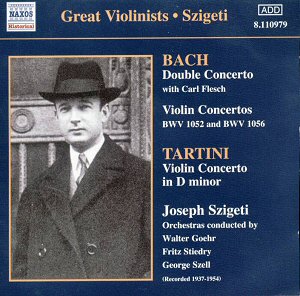One
of the most vibrant and life-affirming recordings of a Handel
sonata in the inter-war period was Szigeti’s. He remained
in the main an expressive and convincing romanticised exponent
of baroque repertoire, amongst so much else. However, not all
his recordings were so successful. This disc collates some of
the most problematically recorded discs in some of the most problematic
interpretations. The results are illuminating more for Szigeti’s
own playing than as cohesive statements in their own right. I
agree with sleeve-note writer Tully Potter’s trenchant comments
on these matters.
Szigeti recorded a series of baroque works with
Walter Goehr in 1937. The Tartini features a clattery and over-recorded
harpsichord and the accompaniment is stolid. Szigeti’s tone
is characteristically silvery, seldom starved at the top, never
opulent. He’s at his best in the slow movement, which is
expressive without ostentation, but there is some roughness in
his bowing of the small third movement cadenza and the playing
here is inclined to be rather sticky. The Bach Arioso, from the
Clavier Concerto in F minor, is taken from a noisy sounding shellac
but has an affecting simplicity. The Double Concerto with Carl
Flesch was a well-known failure. It’s difficult to believe
that this was an Abbey Road venture so boxy is the sound quality.
Potter says this is the best transfer it’s received and
again I agree. It’s superior to the Pearl, which is not
as clear and has a bigger ration of surface noise and a big improvement
on the LP transfers I have, which were unacceptably murky and
ill defined. As a performance we find that the two soloists don’t
make an especially alluring pairing tonally, and that Goehr’s
accompaniment is over emphatic and rather unsubtle. The soloists
do at least attempt to inject some expression in the slow movement
but they’re up against some plonking accompaniment from
the ad hoc band.
The restored D minor Concerto was put on disc
in New York and suffers another recording limitation – it
was a real 1940 American Columbia shocker, horribly blowsy and
coarse sounding. Some diminuendi and moulded phrasing lead one
to hope that this might be stylistically a more musical, less
clod-hopping accompaniment, than Szigeti received from Goehr but
it turns out to be an illusion. This is still heavy, rough and
approximate. Szigeti’s intonation wanders in the slow movement
(admirers will note that this is “expressive intonation”).
Finally we have the God-awful George Szell conducting G minor
Concerto. The gimlet-eyed Hungarian conductor must have been in
an especially tough mood as he leads his compatriot through a
galumphing, miserable reading. Szigeti exhibits some serious bowing
arm defects, as was often the case in these, his declining years
and his unevenness and unsteadiness is accompanied by a tonal
shrillness. I don’t know what to say about Szell’s
marshalling of the orchestral pizzicato figures except that they’re
truly terrible and that Szigeti’s downward portamenti sound
rather forced. The original recording hardly modifies the stultifying,
remorseless heaviness of the undertaking.
So, some severe caveats about the performances.
As for the transfers by Mark Obert-Thorn we find he is in competition,
at least retrospectively, with some earlier examples on the Biddulph
label (LAB064) made by ... Mark Obert-Thorn. That Biddulph shared
the Tartini, Bach Arioso and D minor Concerto with this Naxos.
The Biddulph retained a fairly high ratio of surface noise, which
Obert-Thorn has here tamed but at considerable cost to the higher
frequencies. The Arioso is much improved on the Biddulph; it sounds
re-pitched and subject to much more sensitive restoration than
the earlier transfer. The Bach Double is, as I said, its best
incarnation on disc. But the Tartini and the D minor are different.
Some will appreciate the quieter surface sound but I found that
the effect is to make congested and boxy recordings even more
so and to lose the treble openness that at least gave some life
to them. The lax orchestral accompaniments allied to too much
filtering on these two works mean that this disc should be viewed
with care.
Jonathan Woolf
.








